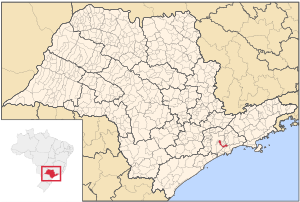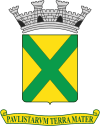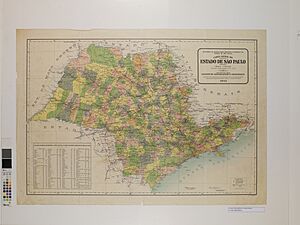Santo André, São Paulo facts for kids
Quick facts for kids
Santo André
|
|||
|---|---|---|---|
|
Municipality
|
|||
| Municipality of Santo André | |||
|
|
|||
|
|||
| Motto(s):
Paulistarum terra mater (Latin)
|
|||

Location in São Paulo
|
|||
| Country | |||
| Region | Southeast | ||
| State | |||
| Named for | Andrew the Apostle | ||
| Area | |||
| • Total | 175.8 km2 (67.9 sq mi) | ||
| Elevation | 700 m (2,300 ft) | ||
| Population
(2022)
|
|||
| • Total | 748,919 | ||
| • Density | 4,260.1/km2 (11,033.5/sq mi) | ||
| Demonym(s) | andreense | ||
| Time zone | UTC-03:00 (BRT) | ||
| Postal code |
09000-000
|
||
| Area code | +55 11 | ||
| HDI (2010) | 0.815 – very high | ||
Santo André (pronounced sahn-too-ahn-DREH) is a city in Brazil. It is located in the large Metropolitan Region of São Paulo. Santo André is part of a group of cities known as the ABC Region. In 2022, about 748,919 people lived there. The city covers an area of 175.8 square kilometers.
Santo André is a very developed city in Brazil. The UN says it is the 15th most developed city in the country. It is also the eighth most developed city in the State of São Paulo. The city is known as one of the best places in Brazil to raise children. This is because of its good public and private schools and healthcare.
Contents
History of Santo André
The first settlement in this area was founded by João Ramalho in 1553. It was called Santo André da Borda do Campo. This first village did not last long. In 1560, the governor-general of Brazil, Mem de Sá, moved the people. They went to live closer to the Jesuit college of São Paulo.
A new town named Santo André appeared much later, in 1938. This happened when the main office of the city of São Bernardo moved. It moved near a train station built in 1867. This train station was part of the São Paulo Railway Company. The new town of Santo André grew very quickly starting in the 1930s.
Santo André is an industrial city. It has many factories that make different things. These include chemicals, textiles, oil products, and metal items. Even though it is an industrial city, more than 60% of its land is protected. This is because of environmental laws that protect water sources. Much of this protected area is in the district of Paranapiacaba.
In 1954, Santo André became the main city for the Roman Catholic Diocese of Santo André.
City Districts
Areas of Santo André
The city of Santo André is divided into several smaller areas called districts:
- Paranapiacaba
- Utinga
- Capuava
People of Santo André
Population by Background
Here is a look at the different groups of people living in Santo André:
| Group | Percentage |
|---|---|
| White | 65.2% |
| Mixed Race | 27.0% |
| Black | 6.4% |
| Asian | 1.3% |
| Indigenous | 0.1% |
Source: Census 2022
Sports in Santo André
Santo André is home to several sports teams and facilities.
Football (Soccer)
- Football Team: The city's main football (soccer) team is Esporte Clube Santo André.
- City Stadium: The team plays at Estádio Bruno José Daniel. It can hold 15,157 fans.
Football Team Achievements
- Brazilian National Cup Champion: In 2004, they won the Brazilian National Cup. They beat Flamengo in the final game. This game was played at Maracanã Stadium in front of over 80,000 Flamengo fans.
- Paulista 2nd Division Champions: They won this title in 1967, 1975, 1981, and 2008.
- Copa Estado de São Paulo: They won this cup in 2003.
- Copa São Paulo Under-20: They won this youth cup in 2002.
- Pelé's First Goal: The famous football player Pelé scored his first professional goal ever in the Santo André Stadium. He was playing for Santos Futebol Clube.
Volleyball
- Men's Volleyball Team: The city had a famous team called Pirelli Volleyball Club.
- World Club Champion: This team won the Men's World Club Championship in 1984. Later, the team changed its name to Shopping ABC. This was due to a new sponsorship deal with Shopping ABC, a large mall in the city.
Basketball
- Men's Basketball Team: The city's team is Pinheiros Santo André. They play in the Paulista League of Basketball.
Boxing
- Olympic Training: The Pedro Dell'Antonia Gymnasium in Santo André hosts the national Olympic boxing team.
Sister Cities
Santo André has special friendly connections with other cities around the world. These are called "sister cities":
 Ribeira Brava, São Nicolau Island, Cape Verde
Ribeira Brava, São Nicolau Island, Cape Verde Takasaki, Gunma, Japan
Takasaki, Gunma, Japan
Famous People from Santo André
Many talented people come from Santo André, including:
- Sandro Dias (Skateboarder)
- Eloy Casagrande (Musician)
- André Domingos (Athlete)
- Beatriz Travalon (Athlete)
- Renato Dias Santos (Footballer)
- Danilo Gentili (Comedian and TV host)
- Daniele Hypólito (Gymnast)
- Diego Hypólito (Gymnast)
- Angélica Ksyvickis (TV host)
- Bruno David Roma (Footballer)
- Lucélia Santos (Actress)
- Milena Toscano (Actress)
Images for kids
See also
 In Spanish: Santo André (São Paulo) para niños
In Spanish: Santo André (São Paulo) para niños








